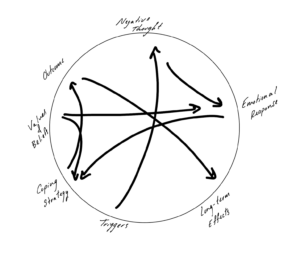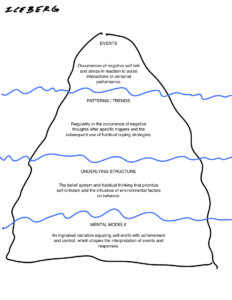For my “Measuring Me” assignment, I’ve chosen to delve into the realm of self-reflection, specifically focusing on my patterns of negative thinking and self-criticism. This introspective journey aims to uncover the triggers and circumstances that lead to such thoughts, as well as the strategies I employ to navigate and move beyond them.
My method involves recording instances where I find myself spiraling into negative or self-critical thinking, detailing not only the time and context of these occurrences but also my response to them. This exercise isn’t about altering my behavior for the sake of the assignment but rather about gaining a true understanding of my thought patterns in their natural state.
To ensure a comprehensive analysis, I selected two distinct days for this exercise. The first day was not necessarily a typically one. It was a weekend where I was traveling with friends. Nonetheless, this helped illustrate interesting behavior. The second day was a more normal class day and includes moments of both busy schedules and downtime. This contrast provides insights into how different contexts influence my thought processes. Each entry chronologically documents the moment a negative thought surfaces and my immediate reaction or strategy to shift my mindset.
Through this self-examination, I aim not only to become more aware of my mental habits but also to explore the effectiveness of various coping mechanisms in real-time situations. Here is a glimpse into this two-day journey of self-awareness and growth.
Reflections on Personal Growth: A Two-Day Journey
Day 1: January 15, 2024
- 9:32 AM – Morning Reflection
Challenge: A friend’s joke lingered in my thoughts.
Overcoming Strategy: Shifted focus to more positive thoughts. - 11:26 AM – Mid-Morning Insight
Challenge: Overthought a minor skiing fall.
Resolution: Reminded myself to not overanalyze. - 1:23 PM – Afternoon Realization
Challenge: Stress from uncompleted work.
Growth Step: Accepted the situation and strategized a solution. - 7:30 AM – Early Social Interaction
Challenge: Awkwardness from a belated New Year’s wish.
Positive Spin: Realized casual conversation doesn’t have to be perfect. - 9:15 PM – Evening Sports Reflection
Challenge: Disappointment over a team loss.
Bright Side: Acknowledged it’s just a game, not a reflection of me. - 11:00 PM – Late Night Contemplation
Challenge: Mixed feelings about enjoying a weekend trip fully.
Positive Recall: Focused on the fun moments shared. - 11:30 PM – Nighttime Anxiety
Challenge: Anxiety about my course load.
Coping Mechanism: Engaged in a relaxing activity to unwind.
Day 2: January 16, 2024
- 8:00 AM – Early Morning Resolve
Challenge: Hesitation about going to the gym.
Action Taken: Overcame laziness to start the day right. - 8:50 AM – Gym Commitment
Challenge: Frustration over tardiness.
Self-Motivation: Concentrated on my workout to clear my mind. - 10:00 AM – Morning Podcast Reflections
Challenge: Questioned my educational engagement.
Shift in Focus: Moved attention to a scheduled call. - 2:00 PM – Afternoon Reflection
Challenge: Disappointment in productivity.
Evening Calm: Accepted the day and prepared for a better tomorrow. - 3:30 PM – Pre-Meeting Stress
Challenge: Regret over procrastination.
Self-Reassurance: Accepted the situation as a learning opportunity. - 9:30 PM – Evening Self-Comparison
Challenge: Felt a need to push myself more in fitness.
New Day Resolution: Committed to gym time in the morning. - 10:30 PM – Late Night Social Thoughts
Challenge: Pondered my social engagement.
Forward-Looking: Planned to find a balance in socializing.

Reflecting on the insights gained from meticulously documenting my thoughts and reactions in the diary, several key takeaways stand out. Firstly, the exercise illuminated the specific triggers that often precipitate a cascade of negative self-talk. These triggers are now not just known but understood, which arms me with the foresight to either avoid them or approach them with a different mindset in the future. The patterns of emotional response that follow these triggers have also become apparent, suggesting a predictive element to my emotional responses that could be preemptively managed.
The evaluation of coping strategies used has been particularly enlightening. Some strategies were evidently more effective than others, and this variance in efficacy offers a blueprint for which strategies to employ in the future. The exercise also brought to light the substantial influence that underlying beliefs and values have on the interpretation of events and reactions. This understanding provides a compelling case for introspection and possible restructuring of these deep-seated beliefs.
The role of the environment, too, cannot be understated. Social interactions and specific settings have been identified as significant contributors to the emergence of negative thoughts, indicating that alterations in my environment or my engagement with it could serve to mitigate such triggers.
Looking ahead, should I choose to repeat this self-observational experiment, I would take a more proactive stance. Armed with the knowledge of what triggers to expect, I could implement coping strategies ahead of time, refining and optimizing them based on past observations. Furthermore, I’d plan to challenge and possibly reshape the underlying beliefs that fuel negative self-perception. Additionally, I would be deliberate in crafting or selecting environments conducive to positive mental health.
In a subsequent iteration of this experiment, I would not only document the negative instances but also pay close attention to any positive shifts in my behavior or thought patterns, aiming to capture a trajectory of change. An analytical approach to this data could reveal deeper insights, such as correlations with time of day or physical well-being, offering a comprehensive understanding of the interplay between my thoughts, emotions, and behaviors. Through this iterative process, I anticipate not just gathering more data but testing and experiencing the effectiveness of adaptive strategies, paving the way for enduring personal growth and resilience.




